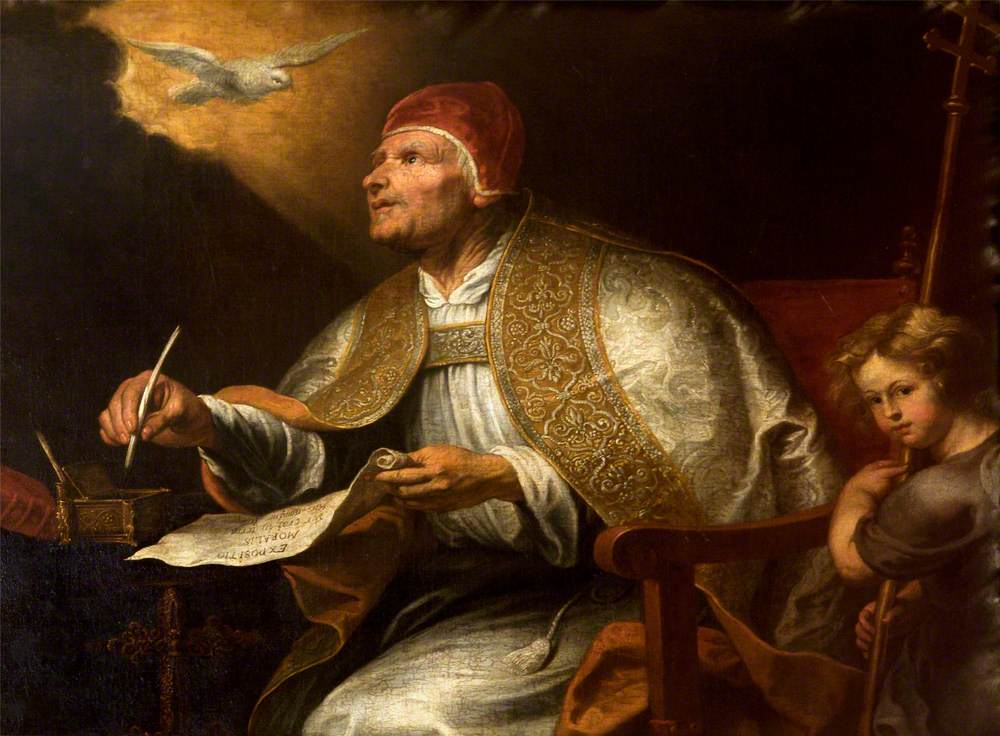Charity, Chant, and Missions

St. Gregory was born into a wealthy Christian family in the year 540. As a young man he studied law and quickly became governor of Rome as a result of his superior legal acumen. However, God ultimately led him to serve the Church through his talents and resources. According to the pattern of Jesus’ instruction, Gregory gave away everything and went and followed his Lord.
After the death of his father, Gregory turned his villa into a monastery dedicated to St. Andrew and took up the monastic life for himself. What he didn’t spend on religious buildings he gave away to the poor. After he became pope he attempted to restructure the church’s collection procedures in order to avoid money-related abuses.
His dedication to charity and almsgiving lasted his whole life, but Gregory was not destined to remain a monk. He reentered the public sphere and was ordained a deacon by Benedict I and later ascended to the bishopric of Rome following the death of Pope Pelagius. During this time disease broke out, turning Gregory’s attention not only to his new role but especially to the needs of the sick and needy in the face of an epidemic.
Gregory’s faith left him no option but to lead a life of servitude and humility, not only in regard to his neighbors but also in matters of the Church’s worship. His liturgical reforms were aimed at creating continuity in faithful worship, like when he had a companion to the missal (the Gregorian Sacramentary) made specifically for the priests and supported musical development in the Church. These had some influence on the simplified compositions created for choirs, what is known today as Gregorian Chant.
Gregory’s habits of ensuring that the poor were served, creating concord with neighboring peoples, and sending out missionaries to the surrounding regions makes him stand out as an early Church father. For many men notable at the beginning of Christianity, they are remembered for their words that defended the Church against attack. For Gregory the Great, however, his actions speak louder than his words. Yet it is important to note that a few of his written works were especially impactful. His Pastoral Rule was quickly translated and adopted as the standard for reforming the pastoral office and the monasteries. Additionally his Morals on Job stands out as another influential work for the monasteries.
Moreover, his work Dialogues on the Life and Miracles of the Italian Fathers is just one example of texts that shaped the piety of many Christians toward Christ through the stories of the saints. In a turbulent time of decline, Rome’s Christians took to the bishop’s book on the wonders of the faith, much like how many today are returning to the wonder of the Christian life in which they find a different way from that of the world.

Brief History
The life and work of St. Gregory the Great continues to influence the Church, including the Lutheran Church—Missouri Synod, which commemorates St. Gregory every year on September 3rd. While many saints’ commemorations are placed on the sanctoral calendar on the day they died, September 3rd is the anniversary of Gregory’s service as bishop of Rome. The dating was arranged to avoid a conflict with the Lenten season, which tends to trump minor liturgical celebrations like Gregory’s death on March 12th.
Collect
O eternal Shepherd, look favorably upon Thy flock and guard it by Thy continual protection: inspire all Pastors through the faithful example of Blessed Gregory, Thy Bishop, to be diligent in their ministry; through Jesus Christ, Thy Son, our Lord, who liveth and reigneth with Thee and the Holy Ghost: ever one God, world without end. Amen.
Lessons
Resources
Issues, Etc. interview with the Rev. Dr. William Weinrich on Gregory the Great
Propers found in Daily Divine Service Book: A Lutheran Daily Missal, edited by the Rev. Heath Curtis
References:
1. Pfatteicher, Philip H. Festivals and Commemorations. Augsburg Publishing House. 1980.
2. Walker, Williston. A History of the Christian Church. Charles Scribner’s Sons. 1985.
Images:
1. St. Gregory the Great writing homilies in his studio with the dove of the Holy Spirit on his right shoulder, Pietro Santi Bartoli after Raphael, Italy, ca. 1650-90.
2. The Four Doctors of the Western Church, Saint Gregory the Great, Gerard Seghers, Belgium, ca. 1600.




[…] understand the tradition for the commemoration of St. Gregory the Great, we need to first step back a couple of centuries prior to the life of Marcus Parcius Cato, or Cato […]